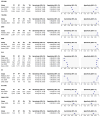Screening for Left Ventricular Hypertrophy Using Artificial Intelligence Algorithms Based on 12 Leads of the Electrocardiogram-Applicable in Clinical Practice?-Critical Literature Review with Meta-Analysis
- PMID: 39997283
- PMCID: PMC11855451
- DOI: 10.3390/healthcare13040408
Screening for Left Ventricular Hypertrophy Using Artificial Intelligence Algorithms Based on 12 Leads of the Electrocardiogram-Applicable in Clinical Practice?-Critical Literature Review with Meta-Analysis
Abstract
Background/Objectives: The increasing utilization of artificial intelligence (AI) in the medical field holds the potential to address the global shortage of doctors. However, various challenges, such as usability, privacy, inequality, and misdiagnosis, complicate its application. This literature review focuses on AI's role in cardiology, specifically its impact on the diagnostic accuracy of AI algorithms analyzing 12-lead electrocardiograms (ECGs) to detect left ventricular hypertrophy (LVH). Methods: Following PRISMA 2020 guidelines, we conducted a comprehensive search of PubMed, CENTRAL, Google Scholar, Web of Science, and Cochrane Library. Eligible studies included randomized controlled trials (RCTs), observational studies, and case-control studies across various settings. This review is registered in the PROSPERO database (registration number 531468). Results: Seven significant studies were selected and included in our review. Meta-analysis was performed using RevMan. Co-CNN (with incorporated demographic data and clinical variables) demonstrated the highest weighted average sensitivity at 0.84. 2D-CNN models (with demographic features) showed a balanced performance with good sensitivity (0.62) and high specificity (0.82); Co-CNN models excelled in sensitivity (0.84) but had lower specificity (0.71). Traditional ECG criteria (SLV and CV) maintained high specificities but low sensitivities. Scatter plots revealed trends between demographic factors and performance metrics. Conclusions: AI algorithms can rapidly analyze ECG data with high sensitivity. The diagnostic accuracy of AI models is variable but generally comparable to classical criteria. Clinical data and the training population of AI algorithms play a critical role in their efficacy. Future research should focus on collecting diverse ECG data across different populations to improve the generalizability of AI algorithms.
Keywords: artificial intelligence; deep learning; electrocardiogram; left ventricle hypertrophy; machine learning.
Conflict of interest statement
The authors declare no conflicts of interest.
Figures





References
-
- Bacharova L., Chevalier P., Gorenek B., Jons C., Li Y.-G., Locati E.T., Maanja M., Pérez-Riera A.R., Platonov P.G., Ribeiro A.L.P., et al. ISE/ISHNE expert consensus statement on the ECG diagnosis of left ventricular hypertrophy: The change of the paradigm. Ann. Noninvasive Electrocardiol. 2024;29:e13097. doi: 10.1111/anec.13097. - DOI - PMC - PubMed
-
- Siranart N., Deepan N., Techasatian W., Phutinart S., Sowalertrat W., Kaewkanha P., Pajareya P., Tokavanich N., Prasitlumkum N., Chokesuwattanaskul R. Diagnostic accuracy of artificial intelligence in detecting left ventricular hypertrophy by electrocardiograph: A systematic review and meta-analysis. Sci. Rep. 2024;10:15882. doi: 10.1038/s41598-024-66247-y. - DOI - PMC - PubMed
Publication types
LinkOut - more resources
Full Text Sources

